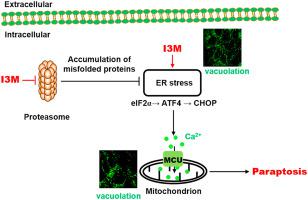Archives of Biochemistry and Biophysics ( IF 3.8 ) Pub Date : 2020-12-13 , DOI: 10.1016/j.abb.2020.108723 Matharage Gayani Dilshara , Ilandarage Menu Neelaka Molagoda , Rajapaksha Gedara Prasad Tharanga Jayasooriya , Yung Hyun Choi , Cheol Park , Gi-Young Kim

|
Purpose
Indirubin-3′-monoxime (I3M) induces cell death in many cancer cells; however, whether I3M regulates paraptosis is unclear. The present study aimed to investigate I3M-induced paraptosis.
Methods
We treated various cancer cells with I3M, and measured vacuole formation (a paraptosis marker) and the regulating signaling pathway such as endoplasmic reticulum (ER) stress, reactive oxygen species, and proteasomal dysfunction.
Results
We found that I3M induced small vacuole formation in MDA-MB-231 breast cancer cells and transient knockdown of eIF2α and CHOP significantly downregulated vacuolation in the ER and mitochondria, as well as cell death in response to I3M, indicating that I3M-meditaed paraptosis was upregulated by ER stress. Moreover, I3M accumulated ubiquitinylated proteins via proteasome dysfunction, which stimulated ER stress-mediated Ca2+ release. A Ca2+ chelator significantly downregulated vacuolation in the ER and mitochondria as well as cell death, suggesting that Ca2+ was a key regulator in I3M-induced paraptosis. Our results also revealed that Ca2+ finally transited in mitochondria through mitochondrial Ca2+ uniporter (MCU), causing I3M-mediated paraptosis; however, the paraptosis was completely inhibited by, ruthenium red, an MCU inhibitor.
Conclusion
I3M induced proteasomal dysfunction-mediated ER stress and subsequently promoted Ca2+ release, which was accumulated in the mitochondria via MCU, thus causing paraptosis in MDA-MB-231 breast cancer cells.
中文翻译:

Indirubin-3'-monoxime通过将Ca 2+从内质网传递到线粒体,从而诱导MDA-MB-231乳腺癌细胞发生截瘫
目的
Indirubin-3'-monoxime(I3M)诱导许多癌细胞死亡。但是,I3M是否能调节截瘫尚不清楚。本研究旨在调查I3M诱发的截瘫。
方法
我们用I3M处理了各种癌细胞,并测量了液泡形成(一种麻痹性标记)和调节信号传导途径,例如内质网(ER)应激,活性氧和蛋白酶体功能障碍。
结果
我们发现I3M诱导了MDA-MB-231乳腺癌细胞中的小液泡形成,eIF2α和CHOP的瞬时敲低显着下调了ER和线粒体中的空泡化以及响应I3M的细胞死亡,这表明I3M介导的上睑下垂是ER压力上调。此外,I3M通过蛋白酶体功能障碍积聚泛素化蛋白,从而刺激内质网应激介导的Ca 2+释放。Ca 2+螯合剂可显着下调ER和线粒体的空泡以及细胞死亡,这表明Ca 2+是I3M诱导的截瘫的关键调节剂。我们的结果还表明,Ca 2+最终通过线粒体Ca 2+单向转运蛋白(MCU)在线粒体中转运,引起I3M介导的截瘫。但是,MCU抑制剂钌红完全抑制了麻痹。
结论
I3M诱导蛋白酶体功能障碍介导的内质网应激,并随后促进Ca 2+释放,Ca 2+释放通过MCU累积在线粒体中,从而在MDA-MB-231乳腺癌细胞中引起截瘫。











































 京公网安备 11010802027423号
京公网安备 11010802027423号